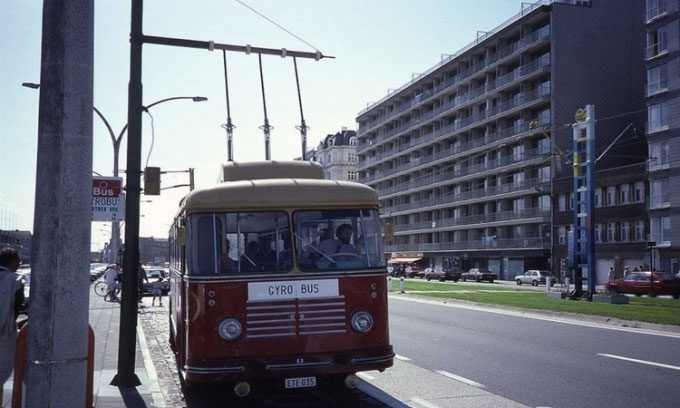In the 1940s, Swiss engineers developed a new type of emission-free electric bus that utilized a large flywheel to store energy instead of using rechargeable batteries.
At that time, many Swiss cities used trolleybuses (operating on electricity supplied from overhead cables) as public transportation, following fixed routes. Installing overhead power lines on new routes was too costly, according to Amusing Planet. To create a smoother and cleaner vehicle, unrestricted by overhead wires, Bjarne Storsand, the chief engineer at Maschinenfabrik Oerlikon, conceived the idea of the gyrobus in 1946.

Currently, there is only one gyrobus left in the world located in Antwerp, Belgium. (Photo: Amusing Planet).
The gyrobus operates using an electric motor that is powered by electricity generated from a flywheel energy storage system. The flywheel rotates at the charging station thanks to three long arms placed on top of the vehicle. When the flywheel reaches a maximum speed of 3,000 RPM, it is fully charged. At this point, the bus can travel 6 km at speeds of 50 – 60 km/h, depending on the load and the gradient of the route. Sometimes, the gyrobus can even cover up to 10 km on a single charge.
The flywheel used by the engineers is quite large (with a diameter of 160 cm) and heavy (1.5 tons), enclosed within a sealed chamber filled with hydrogen at reduced pressure to minimize resistance. The stationary charging time for the flywheel lasts 40 minutes, but when the flywheel is in motion, the time to add more energy only takes 2 – 5 minutes. The higher the voltage, the shorter the charging time. Charging stations along the route ensure that the flywheel’s revolutions never drop to a level that would affect the bus’s performance and speed. For example, the 4.5 km route in Yverdon-les-Bains has up to 4 charging points.
However, placing a large rotating flywheel inside the vehicle led to two unintended consequences. The gyroscopic effect of the flywheel made it difficult for the bus to change direction, resulting in some challenging situations, especially when navigating turns. On the other hand, the system provided a very smooth and balanced ride.
The gyrobus was used in limited numbers in several cities, including Switzerland, Belgium, and Belgian Congo, until 1960. The gyrobus system in Léopoldville even had 12 vehicles operating on 4 routes covering approximately 20 km. However, the high energy consumption led to the system being shut down. Similarly, the gyrobus service in Ghent, Belgium, and Yverdon-les-Bains also ended due to economic issues. Today, only one gyrobus remains, restored, preserved, and displayed at the Flemish Bus and Tram Museum in Antwerp.


















































